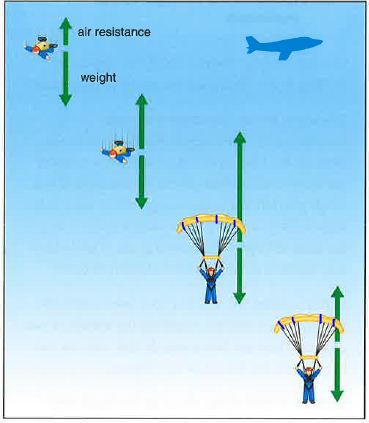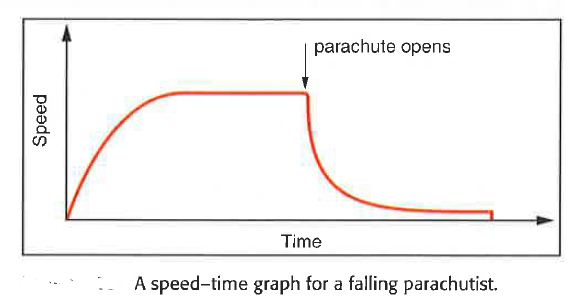How does Parachute motion happen under gravity and air drag? Explain with time graph
Last updated on April 23rd, 2021 at 11:26 am
Parachute motion under the influence of gravity and air drag (resistance) and the speed-time graph of this fall – This is the topic of this post. And we will cover this step by step.

How does Parachute motion happen under gravity and air drag?
1) A free-fall parachutist jumps out of the aircraft and accelerates downwards.
At first air resistance or air-drag has little effect on the parachutist.
(air resistance is directly proportional to velocity and the relatively lower initial velocity of the diver in initial moments can’t make the air resistance considerable enough at this point)
So primarily the gravity (i.e. the weight mg) works on the parachutist and it acts obviously downwards.
2) As he falls primarily under the influence of gravity (air resistance being small), the velocity of the parachutist increases every second of the fall.
3) As air resistance is directly proportional to the speed of the falling object, so it increases as he falls. And eventually, at some point, this resistive or drag force becomes equal to the weight of the falling parachutist and it balances his weight.
4) At this point, the net force on the parachutist is zero. Hence the parachutist stops accelerating – he falls at a steady rate known as the terminal velocity.
5) Opening the parachute greatly increases the area and hence the air resistance also increases.
Now there is much bigger force upwards. That means upward air resistance is more than the downward weight of the parachutist. The forces on the parachute are again unbalanced.
And net upward force causes retardation to the downward fall and the parachutist slows down in his falling.
6) As the speed of the falling parachutist decreases, the amount of air resistance also decreases. ( as said earlier, air resistance is directly proportional to the speed of the falling body).
7) And as air resistance continues to decrease with the decreasing speed of the falling parachutist, at some point, it again becomes equal to the weight of the parachutist. So, the forces on the parachute are balanced or the net force is zero, so no acceleration again.
8) And the parachutist (or the skydiver) reaches a steady terminal velocity. This is the second terminal velocity (please note this)
The idea is to reach a newer and slower terminal velocity of 10 m/s, at which speed he can land safely. With this terminal velocity finally the person lands.
speed-time graph of the falling parachutist or skydiver
The graph shows how the parachutist’s speed changes during a fall.
1) When the graph is horizontal, speed is constant and forces are balanced.
2) When the graph is sloping, the speed is changing. the parachutist ie either accelerating or retarding, and forces are unbalanced.

